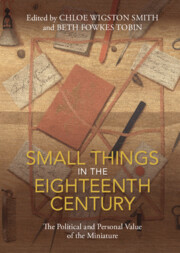Book contents
- Small Things in the Eighteenth Century
- Small Things in the Eighteenth Century
- Copyright page
- Contents
- Figures
- Notes on Contributors
- Acknowledgments
- Introduction
- Part I Reading Small Things
- 1 “The Sum of All in All”
- 2 Nuts, Flies, Thimbles, and Thumbs
- 3 Gothic Syntax
- 4 Small, Familiar Things on Trial and on Stage
- Part II Small Things in Time and Space
- Part III Small Things at Hand
- Part IV Small Things on the Move
- Afterword
- Select Bibliography
- Index
1 - “The Sum of All in All”
The Miniature Book and the Nature of Legibility
from Part I - Reading Small Things
Published online by Cambridge University Press: 29 September 2022
- Small Things in the Eighteenth Century
- Small Things in the Eighteenth Century
- Copyright page
- Contents
- Figures
- Notes on Contributors
- Acknowledgments
- Introduction
- Part I Reading Small Things
- 1 “The Sum of All in All”
- 2 Nuts, Flies, Thimbles, and Thumbs
- 3 Gothic Syntax
- 4 Small, Familiar Things on Trial and on Stage
- Part II Small Things in Time and Space
- Part III Small Things at Hand
- Part IV Small Things on the Move
- Afterword
- Select Bibliography
- Index
Summary
The preface to a mid-seventeenth century edition of Verbum Sempiternum declares that “though the Volume and the Work be smal, / Yet it containes the sum of All in All.” A miniaturized devotional work, it uses its size to frame a tension between human and divine scale, and in doing so, it demonstrates the way in which all kinds of miniature texts of the eighteenth century played with the idea of a large subject in small form. This chapter uses examples of a series of miniature books published across the late seventeenth and eighteenth centuries to explore questions of materiality, utility, scale, and legibility. Miniature books worked on the premise of totality made accessible through compression. We might see them as a kind of epistemological comfort blanket, the promise of a world of knowledge and information that their readers could own, wear, display. And in the virtuosity of their execution, their acts of precision engraving, typesetting, and binding, they offered fine examples of human ingenuity. But at the same time, in reducing the most important documents of Western faith and civilization into compact form, they also raised questions about their own credibility.
Keywords
- Type
- Chapter
- Information
- Small Things in the Eighteenth CenturyThe Political and Personal Value of the Miniature, pp. 15 - 30Publisher: Cambridge University PressPrint publication year: 2022

